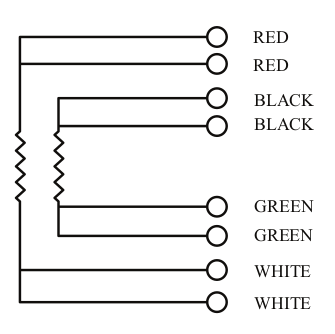Calculate the SCFM.
Temperature Sensors
General RTD Specifications
Standard Platinum RTD Assemblies
Convectronics’ standard RTD assemblies are constructed using wire wound platinum elements with a reference resistance of 100 Ohms at 0°C., a temperature coefficient of .00385 Ohms/Ohm/C (European Standard) or .003916 Ohms/Ohm/C (American Standard) and are in accordance with the following standards:
1. SAMA RC21 – 4 – 1966
2. British Standard, 1904 and 1964
3. German Standard, Din 43760
Other platinum elements and elements of other materials, resistances, and temperature coefficients are available. Please consult with the factory.
RTD Element Terminology
Temperature Co-efficient of Resistance:
The fractional change in element resistance per change of 1°C., expressed as Ohms/Ohm/C.
Accuracy:
A statement of the initial element accuracy as measured at one point only, usually 0°C.
Interchangeability:
An expression of the element material tolerance at various temperatures over the sensor range.
|
SPECIFICATIONS OF STANDARD 100 OHM PLATINUM ELEMENTS |
||
|---|---|---|
| Accuracy: ± .1 OHM (± 3°C) @ 0°C Repeatability: ± .1°C Over Temperature Range Interchangability: |
||
| Temperature | Tolerance | |
| °C | ±°C | ±Ohms |
| -200 | 1.2 | .50 |
| -100 | .7 | .30 |
| 0 | .3 | .10 |
| 100 | .7 | .25 |
| 200 | 1.2 | .45 |
| 300 | 1.8 | .65 |
| 400 | 2.5 | .85 |
| 500 | 3.0 | 1.00 |
| 600 | 3.7 | 1.20 |
| 700 | 4.4 | 1.35 |
Element Types:
Single platinum elements of 100 Ohms at 0°C and duplex platinum elements of two 100 Ohm sensors inside the same sheath are both available as standard. Consult the factory for other duplex style of elements.
Sensor Leadwire:
All standard RTD sensor leadwire is stranded, silver plated copper with either Teflon or Fiberglass insulation. Teflon insulated leads are rated at 400°F maximum and Fiberglass insulated leads are rated at 900°F maximum.
Temperature Limits:
Low Range (L) RTD assemblies are constructed using Teflon materials and low temperature epoxies to make them impervious to moisture penetration. These units are rated at 400°F maximum. High Range (H) RTD assemblies are constructed using pure silver element leads, ceramic insulation, and other materials suitable for maximum temperatures up to 1400°F.
Self Heating:
Self heating is the rise in the measured temperature caused by the power dissipated in the element. Self heating error is affected by the thermal conductivity and velocity of the process being measured and is negligible for most applications. The self heating effect @ 25°C in water flowing at 3 ft./sec. on a 3/16” OD SS sheath diameter RTD is 50 MW/C typical.
General Construction:
Elements are attached to the leads by silver soldering (Low Range) or by silver fusion (High Range) and installed in a specially cleaned and degreased stainless steel sheath. The element is completely encased and sealed in high purity, stress-free ceramic. The element is electrically insulated from the sheath. The sheath is packed with high purity aluminum powder to aid in heat transfer and provide mechanical shock protection.
Time Constant:
The time required to sense 63% of a step temperature change from 25°C to 80°C in water flowing at 3 ft./sec. The time constant for a 3/16” OD SS sheath diameter is 2.0 seconds typical.
Element Connections
RTD sensor assemblies are available with 2, 3, and 4 wire leads. Two wire connected elements do not provide lead resistance compensation for the measuring device. Three and four wire connected elements provide a means for compensating for lead resistance between the sensor and the measuring device.
Two-Wire:
Provides one connection to each end of the element. This construction is suitable where the resistance of the lead wire may be considered as an additive constant in the circuit, and particularly where
the changes in lead resistance due to ambient
temperature changes may be ignored.
2 Wire Single
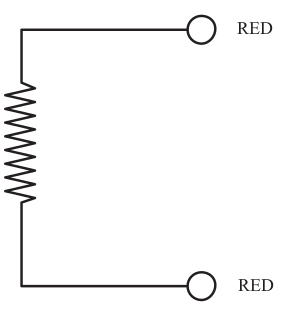

2 Wire Duplex
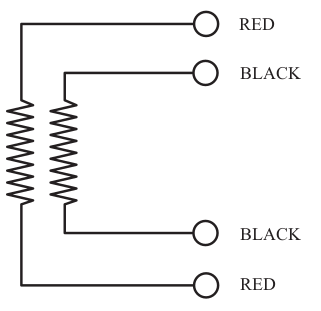

Three-Wire:
Provides one connection to one end of the element and two to the other end of the element. Connected to an instrument designed to accept three wire input, sufficient compensation is usually achieved for leadwire resistance and temperature change in
leadwire resistance. This is the most commonly used configuration.Two-Wire:
Provides one connection to each end of the element. This construction is suitable where the resistance of the lead wire may be considered as an additive constant in the circuit, and particularly where the changes in lead resistance due to ambient
temperature changes may be ignored.
3 Wire Single


3 Wire Duplex
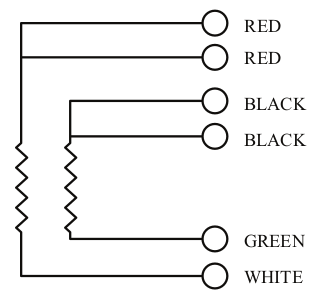

Four-Wire:
Provides two connections to each end of the element to completely compensate for leadwire resistance and temperature change in lead wire resistance. This configuration is used where highly accurate temperature measurement is vital.
4 Wire Single
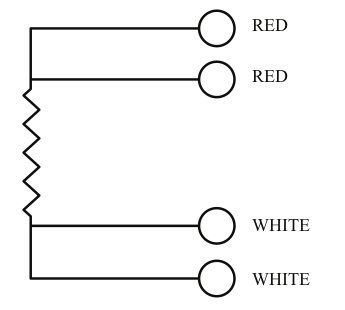

4 Wire Duplex
